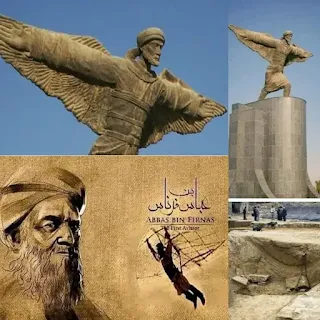He is a multi-talented, broad-minded Muslim scholar with a broad imagination. He was far ahead of his time, and was even distinguished by having preceded the great geniuses who followed him and who were described as being ahead of their time, including Leonardo da Vinci.
His name is Abbas Ibn Firnas. He was born and lived in Cordoba, Andalusia, in the year 810 and died there in the year 887. He was an encyclopedic scientist and inventor who excelled in mathematics, physics, medicine, astronomy, and engineering, and he did not even abandon poetry and music.
In the engineering field, Ibn Firnas was fond of mechanical devices and watches. This remarkable scientist was also interested in crystals, quartz, sand, and glass manufacturing. He took advantage of his extensive knowledge in this field to design a water clock. He also developed a method for producing glass from sand.
Moreover, after experiments with lenses and interest in their magnification properties, he transformed glass made of sand into silica and quartz glass, and in this way created Andalusian drinking cups.
Abbas bin Firnas also succeeded in making a mixture of glass that made it more transparent and superior to similar products available at that time.
Another of his practical achievements in this field is that he devised a special method for making “reading stones,” a curved lens that can help the visually impaired read.
Also from his long record is that Abbas bin Firnas invented a special method for cutting rock crystal, and with this step, Andalusia, at the height of the generous Islamic civilization there, dispensed with the need to transport its rock crystals to be cut to Egypt, and it was the only one capable of such work at the time.
This is not all. Some researchers believe that after a trip to Iraq, Ibn Firnas transferred the Arabic numeral system to Andalusia, and that he invented a first model for glasses and a “chronometer,” which are very accurate watches used in maritime and air navigation.
As for his attempt to embody the dream that humans have had throughout the ages of flying like birds, Abbas Ibn Firnas kept this genius idea until he got old, reaching the age of 65 years, and apparently he knew the seriousness and difficulty of such an impossible task in relation to the available science and knowledge. In his time.
That was in the year 875. This eminent scholar made two wings from cloth and silk, covering them with panels of light wood, and to be extra cautious, he sewed bird feathers to the garment he was wearing.
He chose a suitable place for this dangerous experiment, and that was in the Jabal Al-Arous area in the Al-Rusafa area in Andalusia. People crowded around him as he stood near a cliff, donned the wings he had created, and took off into the air. According to witnesses, he flew in the air in a circle for 10 minutes, and while returning to the top of the slope, he fell while trying to land and suffered bruises and an injury to the back area.
The flaw in that experiment was that Ibn Firnas did not take into account the importance of having a tail to help maneuver when landing, as birds do. That experiment was nonetheless described as successful, despite its unpleasant ending. Its importance is that it was unprecedented and practical, and this remarkable scientist preceded his inventor counterparts, such as Leonardo da Vinci (1452 - 1519), by several centuries.
British writer John Harding, for example, considers Abbas ibn Firnas' experiment to be the first attempt at heavier-than-air flight in the history of aviation.
China : More than 100,000 artifacts were found in a site from the Paleolithic Age
Chinese archaeologists have found more than 100,000 artifacts at the Paleolithic site of Minshihe.
According to the Chinese Xinhua News Agency, this site is located in Lichi County, Sichuan Province (southwestern China). This discovery has been listed among the six most important archaeological discoveries of 2023 in China.
According to scientists' estimates, the age of the site ranges between 50-70 thousand years. The soil contains the remains of organic materials, including animal fossils, ebony, and plant seeds.
According to scientist Cheng Jixuan, from the Sichuan Provincial Archaeological Institute, the summer flood of 2019 eroded the soil and revealed fossils of ebony and animals that had been buried underground for tens of thousands of years, as well as some stone tools used by ancient people. Preliminary analysis showed that ancient people lived in this location close to the water source. It turns out that the level of this site is below the water level of the Meanshi River, yet there is a lot of organic matter in the moist soil.
Xinhua
It should be noted that in 2023, archaeologists found more than 105,000 different artifacts, and more than 60,000 organic remains - plant seeds and others. They also found traces of fire, engravings on wood, as well as the remains of various animals.
Tags:
abbas ibn firnas
andalusia
broad minded
cordoba
first human wings
great geniuses
multi talented
muslim scholar
science
sky man
superfast iq
wings man
world first aviator

